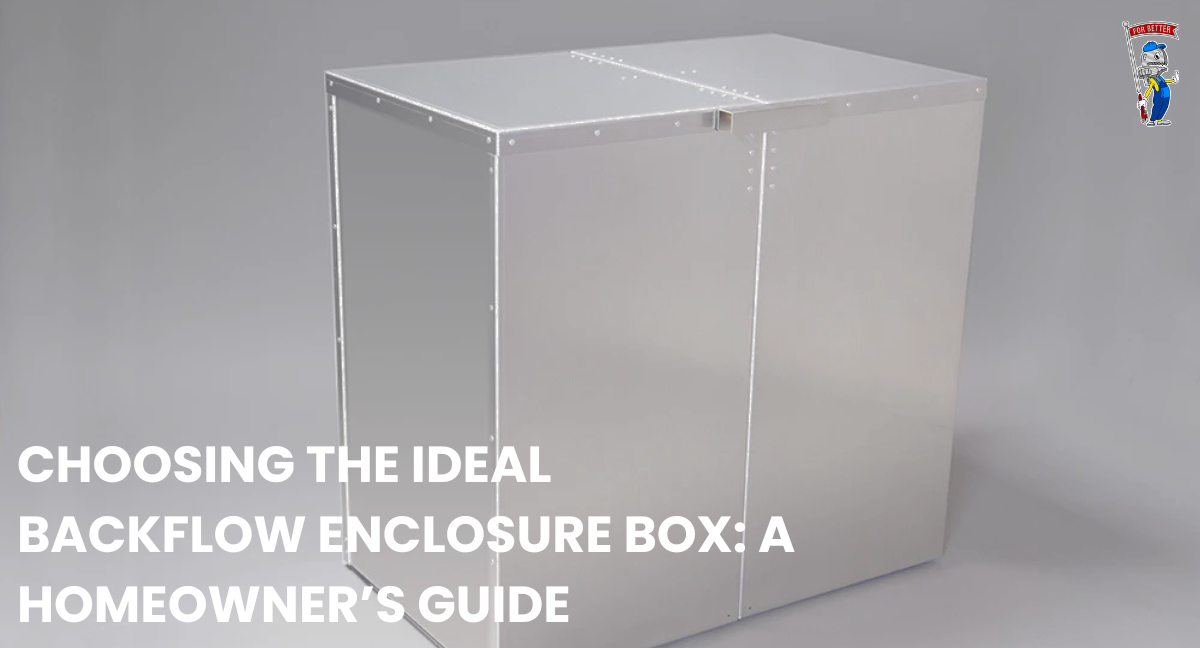Choosing the right backflow enclosure box is critical to ensuring the safety and reliability of your water supply system. It involves selecting a material that suits your environmental conditions and durability needs—plastic for its affordability and resistance to corrosion in residential settings, or fiberglass and metal for their robustness in commercial and industrial environments. Size compatibility is crucial to accommodate your backflow preventer adequately and allow for easy maintenance access. Ensuring regulatory compliance with local standards is essential to avoid legal issues and ensure the system operates effectively.
Additionally, opting for security-enhanced features like locks or tamper-proof designs helps prevent unauthorized access and vandalism, safeguarding the integrity of your backflow prevention setup. Proper installation following manufacturer guidelines ensures the enclosure box performs optimally and maintains system longevity, providing peace of mind regarding your water quality and regulatory adherence.
Importance of Choosing the Right Enclosure
1.) Protecting Water Quality
A backflow enclosure prevents contaminants from entering the clean water supply. By choosing an enclosure box that meets regulatory standards and provides adequate protection, you ensure that your water remains safe for consumption and daily use.
2.) Ensuring Regulatory Compliance
Local regulations often mandate the installation of backflow preventers and enclosures to safeguard public health. Choosing an enclosure that complies with these regulations not only prevents potential fines but also demonstrates your commitment to maintaining a safe environment.
3.) Enhancing Durability and Longevity
The right enclosure is durable and weather-resistant, capable of withstanding environmental factors such as extreme temperatures and physical impacts. This durability reduces the risk of damage to the backflow preventer, ensuring long-term functionality and reliability.
4.) Facilitating Maintenance and Accessibility
An appropriately chosen enclosure facilitates easy access for inspections, maintenance, and repairs. This accessibility ensures that professionals can promptly address any issues, minimizing downtime and potential risks to your water system.
5.) Improving Security Measures
Enclosure boxes with security features, such as locks or tamper-proof designs, prevent unauthorized access and tampering. This added security protects the integrity of your backflow prevention system, reducing the likelihood of malicious interference.
6.) Customizing to Your Needs
Every property has unique requirements based on its size, location, and specific challenges. Choosing a backflow enclosure that can be customized to meet these needs ensures optimal performance tailored to your property’s circumstances.
Factors to Consider When Choosing a Backflow Enclosure Box
When choosing a backflow enclosure box, several factors should guide your decision-making process:
Regulatory Compliance:
Ensure the enclosure box meets local and national regulations for backflow prevention devices. Compliance is crucial to avoid penalties and protect public health.
Material Durability:
Select a material (such as plastic, fiberglass, or metal) that offers durability and weather resistance suitable for your climate and environmental conditions.
Size and Compatibility:
Choose an enclosure box that accommodates the size and type of your backflow preventer. It should provide ample space for maintenance access and proper installation.
Climate Considerations:
If you live in an area with extreme temperatures, consider insulation or ventilation features to protect the backflow preventer from freezing or overheating.
Security Features:
Opt for an enclosure box with security enhancements like locks or tamper-proof mechanisms to prevent unauthorized access and vandalism.
Maintenance Accessibility:
Ensure the enclosure allows for easy access to the backflow preventer for routine inspections, testing, and maintenance. Accessibility facilitates timely upkeep and reduces downtime.
Budget and Cost-effectiveness:
Balance the cost of the enclosure box with its features and durability. Choose a solution that provides long-term value and reliability within your budget constraints.
Installation Requirements:
Follow manufacturer guidelines and local codes for proper installation of the enclosure box and backflow preventer. Ensure it is securely anchored and aligned correctly.
Aesthetic Considerations:
If the enclosure box will be visible, consider its appearance and how well it integrates with your property’s aesthetic or landscaping.
Manufacturer Reputation and Support:
Select a reputable manufacturer known for quality products and reliable customer support. Ensure they offer warranties and assistance for installation and maintenance issues.
Size and Installation
Size:
Accommodation of Backflow Preventer:
- Ensure the enclosure box is large enough to comfortably fit the specific model of your backflow preventer.
- Allow sufficient space for any required plumbing connections, valves, and fittings.
Accessibility:
- Choose a size that allows adequate room for maintenance personnel to access the backflow preventer easily.
- Ensure there’s enough clearance for inspections, testing, and repairs without obstruction.
Space for Additional Equipment:
- If needed, account for space to include additional equipment such as insulation, heat tape, or ventilation systems.
- Consider future expansion or upgrades that might require additional space within the enclosure box.
Installation:
Location Suitability:
- Select a suitable location that meets local regulatory requirements and allows for proper drainage.
- Ensure the site is level, stable, and accessible for installation and maintenance activities.
Anchoring and Stability:
- Anchor the enclosure box securely to a concrete pad or stable surface to prevent shifting or movement.
- Follow manufacturer guidelines for anchoring methods to ensure stability and durability.
Clearance Requirements:
- Check clearance requirements for the enclosure box to ensure it complies with building codes and allows sufficient airflow.
- Provide clearance around the box for easy access and ventilation as necessary.
Sealing and Weather Protection:
- Ensure all openings and joints are sealed properly to prevent water ingress and protect the backflow preventer from weather elements.
- Use weather-resistant materials and sealants appropriate for your climate conditions.
Professional Installation:
- Consider hiring a qualified plumber or contractor experienced with backflow preventer installations to ensure proper setup and compliance with regulations.
- Follow manufacturer guidelines and local codes for installation procedures to maintain warranty coverage and system integrity.
Material Considerations
When choosing a material for your backflow enclosure box, several considerations are essential to ensure durability, functionality, and suitability for your specific needs:
1.) Plastic (Polyethylene):
Advantages:
- Lightweight and easy to handle.
- Resistant to corrosion and rust.
- UV-stabilized for prolonged outdoor exposure.
- Cost-effective option for residential and light commercial applications.
Considerations:
- May not offer the same level of impact resistance as other materials.
- Ensure it meets regulatory standards for strength and durability.
2.) Fiberglass:
Advantages:
- High strength-to-weight ratio.
- Excellent resistance to corrosion and weathering.
- Can be molded into various shapes and sizes.
- Suitable for harsh environments and industrial applications.
Considerations:
- Generally more expensive than plastic.
- Ensure proper insulation or ventilation to prevent overheating or condensation.
3.) Metal (Aluminum or Stainless Steel):
Advantages:
- Strong and durable.
- Provides excellent protection against physical damage and vandalism.
- Resistant to corrosion and rust.
- Suitable for high-security applications and extreme weather conditions.
Considerations:
- More expensive than plastic and fiberglass.
- Can be heavier and more challenging to install.
4.) Composite Materials:
Advantages:
- Combine properties of different materials for specific needs (e.g., strength, weather resistance).
- Offer flexibility in design and functionality.
- Can provide a balance of durability and cost-effectiveness.
Considerations:
- Ensure compatibility with regulatory requirements and installation guidelines.
- Verify long-term performance and maintenance requirements.
5.) Insulated Materials:
Advantages:
- Include built-in insulation to protect against freezing temperatures.
- Prevents condensation and maintains stable temperatures inside the enclosure.
Considerations:
- Ensure adequate ventilation to prevent overheating in warmer climates.
- Verify insulation ratings and suitability for your climate zone.
6.) Custom Materials:
Advantages:
- Tailored to specific project requirements and environmental conditions.
- Provide unique aesthetic or functional features based on design needs.
Considerations:
- Higher cost associated with customization.
- Ensure compatibility with local building codes and regulatory standards.
Choosing the right material for your backflow enclosure box depends on factors such as environmental conditions, installation requirements, durability needs, and budget constraints. Evaluate these considerations carefully to select a material that ensures long-term reliability and protection for your backflow prevention system.
Cost Considerations
Cost varies based on material, size, and additional features. Balancing upfront expenses with long-term durability and functionality is key to making a cost-effective choice. Here’s how to approach cost considerations effectively:
Material Cost: Different materials (such as plastic, fiberglass, or metal) vary in price. Plastic tends to be more affordable initially, while fiberglass and stainless steel offer greater durability but at a higher cost. Consider the balance between upfront investment and long-term durability.
Installation Costs: Factor in installation expenses, including labor and any necessary site preparation. Ensure the chosen enclosure box is straightforward to install to avoid additional costs.
Maintenance Requirements: Evaluate ongoing maintenance needs and costs associated with the chosen material. Plastic may require less maintenance but could be more susceptible to damage over time compared to more durable options like metal.
Regulatory Compliance: Ensure the selected enclosure box meets local and national regulatory standards. Non-compliance can lead to fines or additional retrofitting costs later.
Security Features: Consider the value of security-enhanced features such as locks or tamper-proof designs. While these may increase initial costs, they provide protection against vandalism and unauthorized access, potentially reducing long-term repair expenses.
Warranty and Support: Check for warranties offered by manufacturers. A longer warranty period may indicate confidence in the product’s durability and reduce future repair or replacement costs.
Total Cost of Ownership: Evaluate the total cost of ownership over the expected lifespan of the enclosure box. A higher initial investment in a durable, weather-resistant material may prove more cost-effective in the long run due to reduced maintenance and replacement costs.
By carefully assessing these cost considerations and balancing them with your specific needs and budget constraints, you can make an informed decision when selecting a backflow enclosure box that offers both value and reliability for your water supply system.
About Backflow Services Done Right
At Backflow Services Done Right, we specialize in all aspects of backflow prevention and protection. Our team of experts can guide you through the selection process, ensuring you choose the perfect enclosure box that meets your specific requirements and local regulations. We offer a comprehensive range of backflow services, including backflow repair, backflow installation, backflow maintenance, and testing of backflow preventers and enclosures. Whether you need help with a new installation or upgrading an existing system, our professionals are ready to assist. Don’t leave your water safety to chance – contact us today for personalized advice and top-tier service. Let’s work together to protect your water supply and ensure peace of mind.



